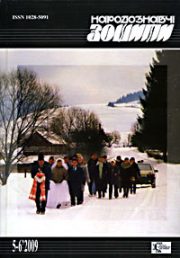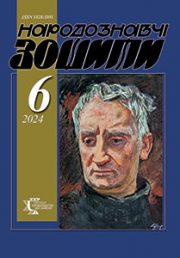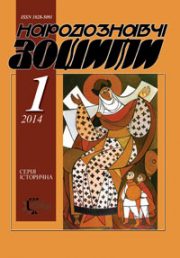The Ethnology Notebooks. 2022. № 6 (168), 1350—1360
UDK 398.1:81’374.2(477.41/.42+477.51)
DOI https://doi.org/10.15407/nz2022.06.1350
MANUFACTURING OF ONE-DAY-MADE FABRIC IN UKRAINIAN POLISSIA TO CAUSE RAIN
VASIANOVYCH Oleksandr
- ORCID ID: https://orcid.org/0000-0001-9360-6447
- Сandidate of History (Ph. D),
- Deputy Director for Research,
- State Scientific Center for Protection
- of Cultural Heritage
- from Technological Disasters,
- 56, ave. Peremogy, 03057, Kyiv, Ukraine,
- Contacts: e-mail: guru_v@ukr.net
Abstract. Introduction. In an attempt to guarantee the harvest and avoid unwanted weather phenomena, the inhabitants of Ukrainian Polissia actively used magical protection means, numerous restrictions on certain types of work on the appropriate days. Occasional rites performed with the aim of causing rain stand out. However, under the influence of the rapid development of education, the general increase in the cultural level, the consciousness of the population of Polish villages was being constantly enriched with scientific knowledge, which led to the leveling of traditional folk beliefs and ideas. Therefore, recording folk meteorological beliefs, organizing a dictionary of folk terms and terminological local variants is quite relevant today.
Problem Statement. The analysis of the collected field data, which characterizes occasional rites during drought, led to the need to analyze the symbolism of the production and use of one-day-made linen, to systematize meteorological material by compiling the appropriate dictionary.
Purpose. Analysis of the symbolism of the production and use of the one-day-made linen for causing rain in the territory of the Ukrainian Polissia based on the author’s field materials.
Methods. The methodology of publication is based on general scientific principles and basic requirements for works of historical and ethnological direction. During the formation of the dictionary, a list of folk terms and terminological concepts was compiled, their content was briefly revealed and illustrated with narratives indicating the geography of life.
Results. Field data collected during 2002—2017 in the northern districts of Volyn, Rivne, Zhytomyr, Kyiv, Chernihiv regions and from migrants from the Chornobyl Exclusion Zone were systematized and put into scientific circulation according to the author’s questionnaire. The dictionary includes terms and terminological expressions used by the inhabitants of Ukrainian Polissia to denote ritual actions for the production and use of the one-day-made linen.
Summary. By the beginning of the 21st century, in memory of the inhabitants of the studied region, there have been preserved many magical talismans for influencing the weather, although their shortening and simplification is observed. Thus, the creation of the one-day-made linen as a certain symbol is characterized by the technological process from the very beginning to its end under certain limitations in time, age, quantity. In the current article, we tried to significantly expand the topic of folk meteorological beliefs, supplementing them with terms and phrases recorded from living folk speech.
Keywords: folk meteorology, folk beliefs, magical actions, drought, one-day-made fabric, one-day-made linen, dictionary, Ukrainian Polissia.
Received 11.11.2022
REFERENCES
- Zelenin, D. (1911). One-day-made towels and one-day-made churches. Zhyvaia starina, І, 1—20 [in Russian].
- Boriak, O. (1996). Fabrication of fabric ritual symbols in Polissia. Polissia: language, culture, history (Pр. 288—295). Kyiv [in Ukrainian].
- Vasianovych, O. (2004). Use of an one-day-made cloth for the purpose of causing rain in the Central Ukrainian Polissya. Towel: symbol, image, sign (Pp. 36—40). Hlukhiv [in Ukrainian].
- Vasianovych, O. (2021). Meteorological Beliefs of Polishchuks (Materials to «Dictionary of Traditional Intangible Culture of the Right-Bank Polissya»). Ethnology notebooks, 6 (162), 1507—1534 [in Ukrainian].
- Chybyrak, S. (2006). Magical actions aimed at protection from thunderstorms and rain, in the traditional culture of Polissya. Past and present of Volyn and Polissya. Kamin-Kashirsky in the history of Volyn and Ukraine (Issue 20, pp. 207—210). Lutsk[in Ukrainian].
- Museum-archive of Ukrainian Polissia Folk Culture of the State Scientific Center for Protection of Cultural Heritage from Technological Disasters (hereafter MAUPFC of SSCPCHTD). Fund Liubeshiv-2015. Dossier or Unit of Issue Vasianovych-D-1 [in Ukrainian].
- MAUPFC of SSCPCHTD. Fund Manevychi-2016. Dossier or Unit of Issue Vasianovych-D-2 [in Ukrainian].
- MAUPFC of SSCPCHTD. Fund Ripky-2017. Dossier or Unit of Issue Vasianovych-D-10 [in Ukrainian].
- MAUPFC of SSCPCHTD. Fund Ripky-2017. Dossier or Unit of Issue Vasianovych-D-13.
- MAUPFC of SSCPCHTD. Fund Korosten-Malyn-2017. Dossier or Unit of Issue Vasianovych-D-6 [in Ukrainian].
- NAS of Ukraine Maksym Rylskyi Institute of Art Studies, Folkloristics and Ethnology the Archival Scientific Funds of Manuscripts and Audio-Recordings (thereafter — NAS of Ukraine Maksym Rylskyi IASFE ASFMAR). Fund 14—5. Dossier or Unit of Issue 885 [in Ukrainian].
- NAS of Ukraine Maksym Rylskyi IASFE ASFMAR. Fund 14—5. Dossier or Unit of Issue 886 [in Ukrainian].
- NAS of Ukraine Maksym Rylskyi IASFE ASFMAR. Fund 14—5. Dossier or Unit of Issue 887 [in Ukrainian].
- NAS of Ukraine Maksym Rylskyi IASFE ASFMAR. Fund 14—5. Dossier or Unit of Issue 889 [in Ukrainian].
- Tolstaya, S. (2012). Number. Slavic Antiquities: Ethnolinguistic Dictionary (Vol. 5, рр. 544—547). Moskva: Mezhdunarodnye otnoshenija [in Russian].
- Plotnikova, A. (2004) Сrossroads. Slavic Antiquities: Ethnolinguistic Dictionary (Vol. 3, рр. 684—688). Moskva: Mezhdunarodnye otnoshenija [in Russian].
- Tolstoj, N. Goviada (Cattle). (1995). Slavic Antiquities: Ethnolinguistic Dictionary (Vol. 1, рр. 503—504). Moskva: Mezhdunarodnye otnoshenija [in Russian].






